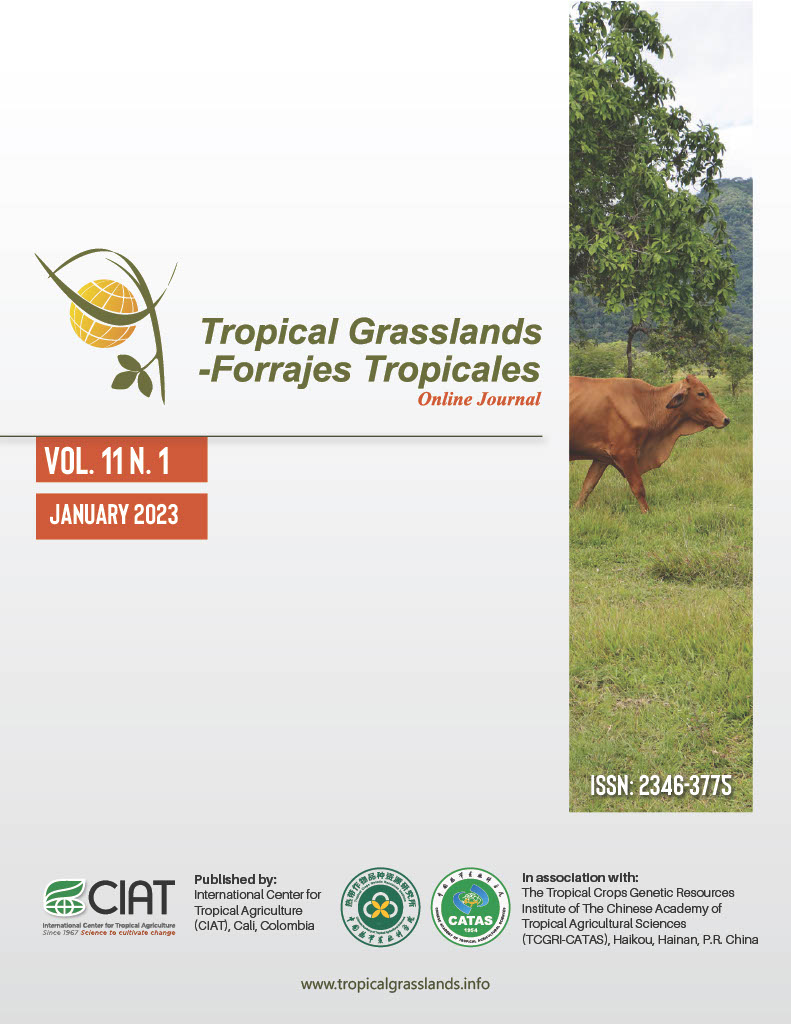Efectos de la intensidad del pastoreo y el tipo de pastura en las reservas de carbono orgánico del suelo en los trópicos semiáridos de la India
DOI:
https://doi.org/10.17138/tgft(11)41-51Resumen
Los pastos pueden actuar como fuentes y sumideros de carbono según la presión del pastoreo y las prácticas de manejo. El stock de carbono orgánico del suelo (SOC) y sus fracciones se cuantificaron bajo 3 intensidades de pastoreo diferentes utilizando 5, 10 y 15 ovejas/ha bajo pasturas sembradas, mejoradas y naturales, en los trópicos semiáridos de la India. Los resultados revelaron que después de 3 años, el suelo bajo pasturas mejoradas tenía partículas significativamente más altas de carbono orgánico (POC ~4.5 g/kg), SOC (~0.53 %), carbono orgánico total (TOC ~7 g/kg) y existencias de SOC (~15 mg/ha) en comparación con pasturas sembradas y pastos naturales. El carbono lábil (LC ~185 mg/kg) y el carbono de la biomasa microbiana del suelo (SMBC ~378 µg/g suelo) fueron más altos en pastos naturales. Una intensidad de pastoreo moderada de 10 ovejas/ha dio como resultado fracciones de carbono, existencias de TOC y SOC significativamente mayores. El stock de SOC y sus fracciones fueron significativamente más altos en las capas superiores del suelo en comparación con las capas del subsuelo. Estos resultados indican que se recomiendan prácticas de manejo de pasturas mejoradas con intensidad de pastoreo moderada para mejorar el stock de COS y sus fracciones en pastizales tropicales semiáridos.
Referencias bibliográficas
Abdalla M; Hastings A; Chadwick DR; Jones DL; Evans CD; Jones MB; Rees RM; Smith P. 2018. Critical review of the impacts of grazing intensity on soil organic carbon storage and other soil quality indicators in extensively managed grasslands. Agriculture, Ecosystems and Environment 253:62–81. doi: 10.1016/j.agee.2017.10.023
AOAC (Association of Official Analytical Chemists). 1990.Official methods of analysis. 15th Edn. AOAC Inc., Arlington, VA, USA.
Banegas N; Corbella R; Viruel E; Plasencia A; Roig B; Radrizzani A. 2019. Leucaena leucocephala introduction into a tropical pasture in the Chaco region of Argentina. Effects on soil carbon and total nitrogen. Tropical Grasslands-Forrajes Tropicales 7:295–302. doi: 10.17138/tgft(7)295-302
Bhattacharyya T; Chandran P; Ray SK; Mandal C; Tiwary P; Pal DK; Maurya UK; Nimkar AM; Kuchankar H; Sheikh S; Telpande BA; Kolhe A. 2015. Walkley-Black recovery factor to reassess soil organic matter: Indo-Gangetic plains and black soil region of India case studies. Communications in Soil Science and Plant Analysis 46:2628–2648. doi: 10.1080/00103624.2015.1089265
Blair GJ; Lofroy RDB; Lisle L. 1995. Soil carbon fractions based on their degree of oxidation, and the development of a carbon management index for agricultural systems. Australian Journal of Agricultural Research 46:1459–1466. doi: 10.1071/AR9951459
Blaser WJ; Shanungu GK; Edwards PJ; Olde Venterink H. 2014. Woody encroachment reduces nutrient limitation and promotes soil carbon sequestration. Ecology and Evolution 4:1423–1438. doi: 10.1002/ece3.1024
Cambardella CA; Elliott ET. 1992. Particulate soil organic‐matter changes across a grassland cultivation sequence. Soil Science Society of America Journal 56:777–783. doi: 10.2136/sssaj1992.03615995005600030017x
Campbell CA; Lafond GP; Biederbeck VO; Wen G; Schoenau J; Hahn D. 1999. Seasonal trends in soil biochemical attributes: Effects of crop management on a Black Chernozem. Canadian Journal of Soil Science 79:85–97. doi: 10.4141/S98-029
Cao J; Wang X; Sun X; Zhang L; Tian Y. 2013. Effects of grazing intensity on soil labile organic carbon fractions in a desert steppe area in Inner Mongolia. SpringerPlus 2:S1. doi: 10.1186/2193-1801-2-S1-S1
Carter JO; Howden SM; Day KA; McKeon GM. 1998. Soil carbon, nitrogen and phosphorus and biodiversity in relation to climate change. In: McKeon GM; Carter JO; Day KA; Hall WB; Hoyden SM, eds. Evaluation of the impact of climate change on northern Australian grazing industries. Final report for the Rural Industries Research and Development Corporation Project, Queensland Department of Primary Industries, Brisbane, Australia. p. 185–249.
Conant RT; Cerri CE; Osborne BB; Paustian K. 2017. Grassland management impacts on soil carbon stocks: a new synthesis. Ecological Applications 27:662–668. doi: 10.1002/eap.1473
Costa OV; Cantarutti RB; Fontes LEF; Costa LM da; Nacif PGS; Faria JC. 2009. Soil carbon stock under pasture in the coastal tableland areas in southern Bahia State, Brazil. Revista Brasileira de Ciência do Solo 33:1137–1145. (In Portuguese). doi: 10.1590/S0100-06832009000500007
Fisher MJ; Thomas RJ; Rao IM. 1998. Management of tropical pastures in the acid-soil savannas of South America for carbon sequestration in the soil. In: Lal R; Kimble JM; Follett RF; Stewart BA, eds. Management of carbon sequestration in soil. CRC Press, Boca Raton, FL, USA. p. 405–420. doi: 10.1201/9781351074254
Havstad KM; Peters DP; Skaggs R; Brown J; Bestelmeyer B; Fredrickson E; Herrick J; Wright J. 2007. Ecological services to and from rangelands of the United States. Ecological Economics 64:261–268. doi: 10.1016/j.ecolecon.2007.08.005
Jobbágy EG; Jackson RB. 2000. The vertical distribution of soil organic carbon and its relation to climate and vegetation. Ecological Applications 10:423–436. doi: 10.1890/1051-0761(2000)010[0423:TVDOSO]2.0.CO;2
Krishna MP; Mohan M. 2017. Litter decomposition in forest ecosystems: a review. Energy, Ecology and Environment 2:236–249. doi: 10.1007/s40974-017-0064-9
Li ZW; Nie XD; Chen XL; Lu YM; Jiang WG; Zeng GM. 2015. The effects of land use and landscape position on labile organic carbon and carbon management index in red soil hilly region, southern China. Journal of Mountain Science 12:626–636. doi: 10.1007/s11629-013-2964-2
Ma XZ; Wang YF; Wang SP; Wang JZ; Li CS. 2005. Impacts of grazing on soil carbon fractions in the grasslands of Xilin River Basin, Inner Mongolia. Chinese Journal of Plant Ecology 29:569–76. doi: 10.17521/cjpe.2005.0076
Maia SMF; Ogle SM; Cerri CEP; Cerri CC. 2009. Effect of grassland management on soil carbon sequestration in Rondônia and Mato Grosso states, Brazil. Geoderma 149:84–91. doi: 10.1016/j.geoderma.2008.11.023
McGill WB; Cannon KR; Robertson JA; Cook FD. 1986. Dynamics of soil microbial biomass and water-soluble organic C in Breton L after 50 years of cropping to two rotations. Canadian Journal of Soil Science 66:1–19. doi: 10.4141/cjss86-001
Morgan JA; Parton W; Derner JD; Gilmanov TG; Smith DP. 2016. Importance of early season conditions and grazing on carbon dioxide fluxes in Colorado shortgrass steppe. Rangeland Ecology & Management 69:342–350. doi: 10.1016/j.rama.2016.05.002
National Remote Sensing Centre. 2010. Wastelands Atlas of India 2010. Department of Land Resources, Ministry of Rural Development, New Delhi, India. bit.ly/3kA5iVP
NITI Aayog. 2018. Demand and supply projections towards 2033. Crops, Livestock, Fisheries and Agricultural Inputs, Working Group Report, New Delhi, India. bit.ly/3DfAgsO
Ogle SM; Conant RT; Paustian K. 2004. Deriving grassland management factors for a carbon accounting method developed by the intergovernmental panel on climate change. Environmental Management 33:474–484. doi: 10.1007/s00267-003-9105-6
Oliveira SP de; Lacerda NB de; Blum SC; Escobar MEO; de Oliveira TS. 2015. Organic carbon and nitrogen stocks in soils of northeastern Brazil converted to irrigated agriculture. Land Degradation & Development 26:9–21. doi: 10.1002/ldr.2264
Pachas ANA; Shelton HM; Lambrides CJ; Dalzell SA; Murtagh GJ; Hardner CM. 2018. Effect of tree density on competition between Leucaena leucocephala and Chloris gayana using a Nelder Wheel trial. II. Belowground interactions. Crop and Pasture Science 69:733–744. doi: 10.1071/CP18040
Radrizzani A. 2009. Long-term productivity of leucaena (Leucaena leucocephala)-grass pastures in Queensland. Ph.D. Thesis. The University of Queensland, Brisbane, Australia. espace.library.uq.edu.au/view/UQ:195473
Radrizzani A; Nasca JA. 2014. The effect of Leucaena leucocephala on beef production and its toxicity in the Chaco Region of Argentina. Tropical Grasslands-Forrajes Tropicales 2:127–129. doi: 10.17138/tgft(2)127-129
Rai SK; Dixit AK; Choudhary M; Kumar S. 2018. Climatic variability and prediction of annual rainfall using stochastic time series model at Jhansi in central India. Mausam 69:73–80. doi: 10.54302/mausam.v69i1.232
Sampaio EVSB; Costa TL da. 2011. Stocks and fluxes of carbon in semiarid Northeast Brazil: preliminary estimates. Revista Brasileira de Geografia Física 6:1275–1291 (In Portuguese). doi: 10.26848/rbgf.v4i6.232783
Saraiva FM; Dubeux Jr JC; Lira MDA; Mello AC de; Santos MV dos; Cabral FDA; Teixeira VI. 2014. Root development and soil carbon stocks of tropical pastures managed under different grazing intensities. Tropical Grasslands-Forrajes Tropicales 2:254–261. doi: 10.17138/tgft(2)254-261
SAS Institute. 2011. SAS/STAT. Version 9.3 for Windows. SAS Institute, Inc., Cary (NC, USA).
Schlesinger WH; Ward TJ; Anderson J. 2000. Nutrient losses in runoff from grassland and shrubland habitats in southern New Mexico: II. Field plots. Biogeochemistry 49:69–86. doi: 10.1023/A:1006246126915
Scurlock JM; Hall DO. 1998. The global carbon sink: a grassland perspective. Global Change Biology 4:229–233. doi: 10.1046/j.1365-2486.1998.00151.x
Shinde AK; Mahanta SK. 2020. Nutrition of small ruminants on grazing lands in dry zones of India. Range Management and Agroforestry 41:1–14.
Su YZ; Liu WJ; Yang R; Fan GP. 2009. Carbon sequestration effect following retirement of degraded croplands into alfalfa forage land in the middle of Hexi Corridor region, Northwest China. Acta Ecologica Sinica 29:6385-6391.
van Hall RL; Cammeraat LH; Keesstra SD; Zorn M. 2017. Impact of secondary vegetation succession on soil quality in a humid Mediterranean landscape. Catena 149:836–843. doi: 10.1016/j.catena.2016.05.021
Vance ED; Brookes PC; Jenkinson DS. 1987. An extraction method for measuring soil microbial biomass C. Soil Biology and Biochemistry 19:703–707. doi: 10.1016/0038-0717(87)90052-6
Walkley A; Black IA. 1934. An examination of the Degtjareff method for determining soil organic matter, and a proposed modification of the chromic acid titration method. Soil Science 37:29–38.
Xie Y; Wittig R. 2004. The impact of grazing intensity on soil characteristics of Stipa grandis and Stipa bungeana steppe in northern China (autonomous region of Ningxia). Acta Oecologica 25:197–204. doi: 10.1016/j.actao.2004.01.004
Zhang M; Li X; Wang H; Huang Q. 2018. Comprehensive analysis of grazing intensity impacts soil organic carbon: a case study in typical steppe of Inner Mongolia, China. Applied Soil Ecology 129:1–12. doi: 10.1016/j.apsoil.2018.03.008
Cómo citar
Descargas
Descargas
Publicado
Número
Sección
Licencia
Derechos de autor 2023 Tropical Grasslands-Forrajes Tropicales

Esta obra está bajo una licencia internacional Creative Commons Atribución 4.0.




